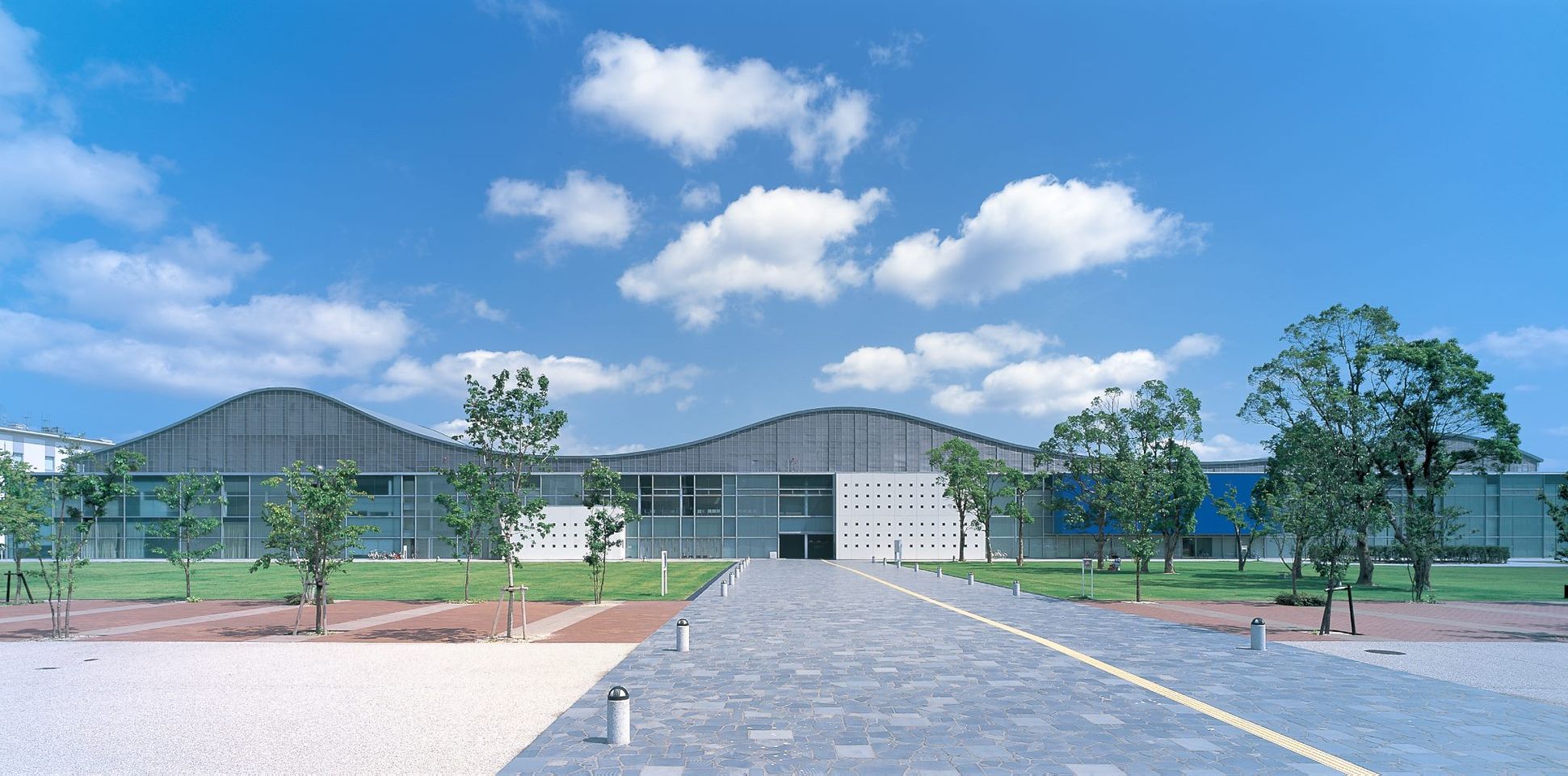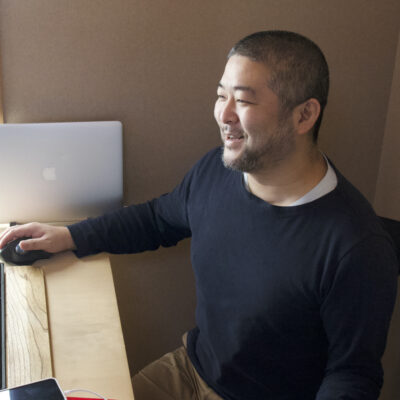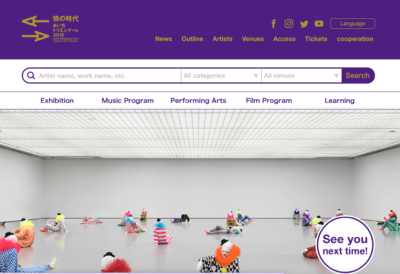When the Workshop is A Live Stage: Educational Programming at Center for Arts and Media, University, and Art Festival
March 18, 2024
Text by Midori Yamanaka with Daiya Aida
“I believe that workshops have a significant element of performing arts. It’s quite challenging because it involves interaction with the audience. It’s not just about following the script; you also have to adapt to the characters of the people who come. ”
– Daiya Aida
YCAM(山口情報芸術センター)は、2003年に地域の文化振興を目指して設立されました。メディアアートを中心とした施設で、教育や社会貢献を重視し、多彩なプログラムを提供しています。例えば、議論と身体実践を繰り返して新たなスポーツをつくる「スポーツハッカソン for Kids」や、調理とおいしさを科学的な視点でとらえる「COOKHACK」、現代社会や自身の身体感覚の理解を深められるものなど、興味深い内容が並んでいいます。会田大也氏はYCAMの立ち上げ当初から関わり、現在は学芸普及課長兼アーティスティックディレクターとして活躍しています。今回は、ワークショップを通じた教育プログラムについてお話を伺いました。
Yamaguchi Center for Arts and Media (YCAM) was established in 2003 with the aim of promoting local culture. As a facility focused on media art, it emphasizes education and social contributions, offering a diverse range of programs. For instance, there are fascinating concepts such as a “Sports Hackathon for Kids,” where new sports are created through repeated discussions and physical practice, “COOKHACK,” which approaches cooking and taste from a scientific perspective, and others that deepen our understanding of contemporary society and our own bodily sensations. Daiya Aida has been involved with YCAM since its inception and currently serves as the Director of Education and Outreach as well as the Artistic Director. In this interview, we discussed the educational programs conducted through workshops.

磯崎新氏が設計を手がけた、YCAMの外観。開かれた協働のコミュニティ、新しいアートセンターとしてスタートした。(画像提供 : 山口情報芸術センター[YCAM])
Exterior of YCAM, designed by Arata Isozaki. YCAM is launched as an open collaborative community and a new art center. (Courtesy of Yamaguchi Center of Arts and Media [YCAM])
Midori : YCAMでの教育プログラムは、どのように作られてきたのでしょうか?
How have educational programs at YCAM been developed?
Daiya : どこの都市でもそうだと思いますけれど、メディアアートって、そんなに馴染みのあるものではないですよね。「メディアアートの施設を作るぞ」って言ったら、「何それ?」って感じで、地元の人々は「不可思議なものが来たな」って反応です。
Like in any city, I think media art isn’t something that people are familiar with. When you say you’re going to create a facility for media art, people are like, “What’s that?” and the locals think, “Something bizarre has arrived.”
なので、「メディアってこういうことですよ」っていう話を僕が勉強していた「メディアヒストリー」「科学技術史としてのメディアのあり方」などを踏まえながら、フラットな言い方をすれば「メディアリテラシー教育」ということに落とし込んでいきました。
So, I took what I had studied, such as “Media History” and “The Role of Media in the History of Science and Technology” and simplified it to what you could call “Media Literacy Education” in a flat way.
具体的には、ワークショップをデザインして参加プログラムを作っていったり、何かに付随するような学習プログラムレクチャーとか、そういったことも含めてプログラムを作っていくっていう仕事でした。
Specifically, it involved designing workshops and creating participatory programs, as well as educational lectures and such. That was the job, including those elements.
Midori : 対象は地元の人ですよね。
Your target audience is the local community, right?
Daiya : 僕らとしては、対象を絞り込むことに意味を感じていませんでした。遠くからやってきた人たちが受けてもいいと思ってましたし、年齢に関しても、小学校4年生以上であれば別に90歳でも100歳でも、何歳でも参加可能という考え方で準備をしていました。メディアっていうのは人間の人生よりも短いスパン登場したので、新しい技術については、小学校4年生だろうが、60歳だろうが同じ時期に、触れ始めたっていうふうに考えることができます。人生経験がある人の方が有利というわけではありません。
For us, we didn’t see any meaning in narrowing down our audience. We thought it would be fine for people who came from far away to participate. As for age, we were prepared for really anyone of any age to participate. Media is a field that has emerged within a shorter span than a human lifetime. So when it comes to new technology, whether you’re a fourth grader or 60 years old, you’re starting to interact with it at the same time. Having life experience doesn’t necessarily give you an advantage.
Midori : なるほど。確かに、むしろ逆ですよね。
I see. That makes sense, actually.
YCAMで11年働いた後、場所と目的は異なるにせよ、東京大学でもプログラムを作られたんですね。
After 11 years of working at YCAM, you created a program at the University of Tokyo as well?

Daiya Aida, who kindly agreed to participate in the interview, despite having only exchanged brief greetings back in 2018.
東京大学での私の仕事は、博士課程の学生に「ワークショップの作り方」を理論的に教え、実際に作成してもらい、その内容を評価することでした。目的は、ICTを駆使して国際的に活躍できるリーダーの育成です。これは、研究や学習を机上のみで行ってきた人たちに、その成果を社会に実装する能力を身につけさせることを目指しています。
東日本大震災時の福島第1原発での燃料デブリ除去プロジェクトを例に、日本製ロボットが機能しなかった一方、DARPA(アメリカ国防高等研究計画局)のロボットが高い利用価値を示したことから、実験室内の成果と現場での有用性の違いを強調しました。この事例を通じて、ロボット工学の専門家が、実際に社会に役立つ研究者を育成する重要性を訴え始めていたんです。
My task at University of Tokyo Graduate School involved teaching doctoral students the theoretical aspects of creating workshops, having them actually create one, and then evaluating the content they developed. The broader goal is to nurture leaders who can operate internationally using ICT. This aims to equip individuals who have traditionally focused their studies and research in academic settings with the ability to implement their findings in society.
In the context of the Fukushima Daiichi nuclear disaster, the failure of Japanese robots during the fuel debris removal project contrasted sharply with the high utility of robots developed by the American DARPA (Defense Advanced Research Projects Agency). This discrepancy highlighted the difference between achieving results in controlled laboratory environments and producing work that is truly valuable in real-world scenarios. It was through this example that experts in robotics began advocating for the education of researchers capable of contributing meaningfully to society.
Midori: 学生たちは、どういう枠組みでワークショップに参加するんですか。
Who actually takes these workshop classes, and how are they structured?
Daiya: 9学科16-17専攻を対象にした多様な専門分野の生徒たちが参加します。彼らの目標は、研究を社会に実装し、その結果を論文に反映させることです。異なるバックグラウンドを持つ生徒たちに対して、ワークショップの基本構造を教え、彼らに自分の研究を社会に適用する方法を学んでもらうのが私の役割です。
The workshop courses I designed targeted a diverse range of students across 9 departments and 16 to 17 majors. We had students from various backgrounds, including those involved in robotics research, pure logic and mathematics, education, and even nursing. The goal was to incorporate workshops into their research papers as a form of societal implementation. My role was to teach them the fundamental structure of workshops and how to adapt them to their research, ensuring they could handle it themselves.
Midori : 実際に教えてみてどうでしたか?
How did it go in practice?
Daiya : 異色な集団で成果は一様ではなかったものの、学生たちは研究の社会実装の難しさを学んだと思います。私や他の担当者が進行計画(スクリプト)を基に評価し、一定の水準に達していなければ再提出を求めます。
It was a unique group, and it’s hard to say how successful it was. However, I believe the students learned a lot about the challenges of implementing research outside their field. It’s not enough to run workshops they’ve designed on their own. My colleagues and I will evaluate based on the design and script provided. Should the submission fail to meet the specified standards, it must be resubmitted for further review.
Midori : その徹底した設計は日本的な感じがします。
That level of planning seems very Japanese.
Daiya : そうかもしれません。しかし、ワークショップの成功は、参加者の心理状態やタイムマネジメント、情報伝達の精度など、多くの要素に依存します。進行計画(スクリプト)がないと、ワークショップを「デザインできた」とは言えません。進行計画作成の練習を通じて、学生たちにはワークショップの流れを頭で描けるようになってもらうことが目標です。
Perhaps, but I’ve always believed that workshops require careful planning, similar to constructing a building or writing a comedy sketch. It’s important to understand the participants’ psychological state, manage timing, and ensure information is clearly communicated. This is why we emphasize a script writing practice, to help students visualize and implement the workshop flow effectively.
Midori : スクリプトがあると、逆にやりにくくなったりしませんか?
Does having a script make it difficult to deviate?
Daiya : それを教えるのが私の仕事です。スクリプトを書けない人ほどうまくいかないことが多いのです。
Teaching how to balance between following and deviating from the script was part of my job. In reality, those who don’t prepare a script often struggle more.
Midori : そうですか!
Really?
Diaya : できても、時間内にフィニッシュまで終わらなかったりする。ワークショップをやる以上は、例えば3時間で計画してたものが4時間5時間になっちゃうのはやっぱ良くない。参加する人たちは、その後の予定がありますから。いろんなハンズオンをやってそれを経験したからこそ、この言葉が響くよねっていう決め台詞を入れるのは重要だとよく話します。パンチラインを言う時間がなくなってしまったら、何のためにやったのか、本末転倒です。
Even if they manage to do it, they often can’t finish within the allotted time. It’s not good for a workshop planned for three hours to stretch into four or five, as participants have other commitments. Having hands-on experience allows us to insert impactful phrases at the right moments. If you run out of time to deliver your punchline, it defeats the purpose of the workshop.
ですから時間のコントロールをするのは非常に重要です。そのためにはスクリプトが書かれていて、もし2分脱線したとしても、最後のここで調整できるとかがわかってないと、アドリブもなかなかできません。なので、セリフ通りに間違えないように話すような、えーと例えるなら、携帯電話ショップの店員の説明マニュアルとは違う「スクリプト」というものを考えています。そうすれば、もし逸脱しても、戻ってくるっていう自由が効く。そのために書いているということを理解してもらっていました。
Thus, time management is crucial. A script helps you adjust; if you deviate for two minutes, you need to know how to compensate later. The aim isn’t to rigidly stick to a script like a cellphone store clerk, but to have a blueprint. Even if you stray from it, you can find your way back, offering a degree of freedom. That’s the purpose of scripting, and it’s something I wanted them to understand and utilize.
Midori : なるほど、すごくよくわかりました。全体的なバリューとの効果を高めるためのタイムマネジメントツールとしてのスクリプト…というか全体のデザインっていうことですね。
I see, that makes a lot of sense. So, it’s about using scripts as a time management tool to enhance the overall value and design of the workshop.
Daiya : 経験のない人はスクリプトを書かないと、どういうワークショップなのか詳細まで想像できないんです。
People who are inexperienced can’t fully imagine what the workshop will be like without a script detailing it.
演劇の台本と同じだと僕は思っています。演劇だって、その通りにやらなきゃ絶対に面白くないってわけじゃない。でも、骨組みがあれば、仲間にサポートをもらったり、その瞬間に必要な指示を出したりもできる。誰もがそのスクリプトを参考にできるんです。
I think of it like a script for a play. It’s not that a play won’t be interesting if it doesn’t follow the script exactly. But when you have a framework, you can call in support members and give them instructions on what you need in the moment. Everyone can refer to the same script.
Midori : 私も、ワークショップには演劇の要素があると思います。「今回はこういうなんかテンションでいこう」とか、「ここはこういうキャラでいこう」みたいにやってます。笑
I also think that workshops have elements of drama. Like saying, “Let’s go with this kind of vibe this time,” or “Let’s play this character here.” (laughs)
Daiya : 僕もワークショップは、パフォーミングアーツの要素が多分にあると思います。しかもそれはお客さんとのインタラクションあって、かなり難しい!スクリプト通りにやればいいってものでもなく、来場してきた人たちのキャラクターにも合わせてやらなければいけない。だからこそ、ある程度骨組みがしっかりしていれば、参加者幅が想定よりも広がっても対応しやすくなると思います。
I believe that workshops have a significant element of performing arts. It’s quite challenging because it involves interaction with the audience. It’s not just about following the script; you also have to adapt to the character of the people who come. That’s why having a solid framework helps to easily accommodate a broader range of participants than anticipated.
Midori : 東京大学大学院で5年務めた後に、YCAMに戻られるわけですが、その前にあいちトリエンナーレで働かれたと。トリエンナーレはどうでしたか。
After serving for five years at the University of Tokyo Graduate School, you returned to YCAM. Before that, just for one year, you worked at the Aichi Triennale, which is held in Aichi Prefecture every three years since 2010, and is one of the largest international art festivals in Japan. How was that experience?
Diaya : とても良い経験でした。そのときはアーティストとしてではなく、運営側のディレクター、ラーニングプログラムのキュレーションとしてクレジットしてもらっています。
It was a very good experience. At that time, I was credited not as an artist but as a director on the operation side, curating the learning program.
Midori : 面白かったことはどんなことですか。
What interested you about the Aichi Triennale?
Daiya : ボランティアさんとの関わりです。愛知県におけるボランティアの起源は、2005年の愛地球博で、多くの市民がボランティア活動に目覚めました。2019年には、あいちトリエンナーレに約1,200人の登録ボランティアがいて、大規模な組織が形成されました。その年、彼らに対話的な鑑賞方法を伝えることは非常に興味深かったです。
My interaction with the volunteers. The roots of volunteering in Aichi Prefecture trace back to the 2005 World Exposition, which inspired many citizens to volunteer. The Aichi Triennale had about 1,200 registered volunteers in 2019, forming a massive organization. It was fascinating to teach them about Visual Thinking Strategies.
大地の芸術祭 越後妻有アートトリエンナーレや瀬戸内国際芸術祭などを手がけ、アートフェスティバルのディレクターとして知られる北川フラムさんは、「フェスティバルにおけるアート作品やアーティスト、またキュレーターは入れ替わっても、ボランティア、つまり住民は残る」と話されたそうです。愛知トリエンナーレの芸術監督だった津田大介さんは、そのことを繰り返し話していました。そのことに、僕もすごく共感しています。
Fram Kitagawa, a well-known art director for many incredible art festivals and Triennales in Japan, mentioned “While artists, artworks, and curators in festivals change rapidly, volunteers, or rather the residents, remain constant.” Daisuke Tsuda, Artistic Director for the Aichi Triennale, has mentioned and referred to this many times during the festival’s preparation period. I also strongly agree with this sentiment.
ビジュアル・シンキング(ストラテジー)は、対話型鑑賞とも言って、アメリカのニューヨーク近代美術館で子ども向けに開発された美術の鑑賞方法です。美術や作品についての知識無しに、作品を楽しむ体験を他人と共有します。それにより、想像力や自分で考える力を育て、コミュニケーションの能力の向上を図るものです。
Visual Thinking (Strategy), is an art appreciation method developed for children at the Museum of Modern Art in New York. It involves sharing the experience of enjoying artwork with others without prior knowledge of art or the piece itself. This fosters imagination, critical thinking skills, and improves communication abilities.
このメソッド通りの本格的なファシリテーションは出来ないとしても、1200人のボランティアが「そういう方法論がある」と知っているだけで、ありがちな「一方的にアートの知識を教える」ということではなくなります。双方向の対話があちこちで展開されるアートフェスティバルのあり方を、模索できると感じました。
Even without full facilitation skills, having 1,200 volunteers aware of this methodology shifts from a one-way teaching approach. I felt that this could be a way to explore the possibility of an art festival where interactive dialogues unfold everywhere.
Midori : それは、めちゃくちゃパワフルですね。
That sounds powerful.
Diaya : 僕はそう思います。
I think so.
Midori : 他に、どんなことを考えていらっしゃいますか?今取り組んでいることも含めて教えてください。
What else are you thinking about? Please include what you are currently working on as well.
Daiya : メディア芸術のアートセンターで働いている立場で言うのもおかしいかも知れませんが、正直に言えば僕自身は、メディア芸術というジャンル自体が守られることには、あまり興味がないんです。もちろん、人類の社会とか人類史、文明史みたいなものを考えたときに、メディアが重要な役割と意味を持ってるとは思っています。メディアというものがあるからこそ人は、記憶の方法を変えてきたし、政治の方法を変えてきた。例えば文字を持たなかったマヤ文明というものが一体何だったのか、どういう意味があったのかなど、そういったことまで含めて考えるべきことがいっぱいあると思っています。そういったことを描き出せるのが一番いいですけど、でも、僕だけの力ではどうにもならない。アートが社会に直接役に立つかというと、結果として役に立つこともあるかもしれない、でもそれが目的で作られる作品は疑っている、というのが率直な思いです。
It might sound odd coming from someone who works at a media arts center, but to be honest, I’m not particularly interested in the preservation of the media arts genre itself. Of course, when considering the scope of human society, history, and the history of civilization, I do believe that media plays a crucial role and holds significant meaning. It is through media that humans have changed their methods of remembering and altered their approaches to politics. For example, considering what the Maya civilization, which lacked a writing system, was all about and what it meant, including such aspects, I think there’s a lot to be considered. It would be ideal to be able to depict these things, but it’s not something I can achieve alone. Whether art directly benefits society is debatable; it might end up being useful, but I’m skeptical about works created with that explicit purpose in mind. That’s my candid opinion.
あいちトリエンナーレで、「表現の自由」の問題がクローズアップされました。僕は、アーティストは「社会に役立てよう」と思って作品を作ってるっていうケースがむしろレアだと思っています。アーティストの本音は、「やむにやまれず作っちゃってる」っていうことじゃないかと思っているんです。
The issue of “freedom of expression” was highlighted at the Aichi Triennale. I believe it’s relatively rare for artists to create their works with the intention of “serving society.” In my opinion, artists often create because they are compelled to, not because they want to serve a societal purpose.
ただ、それを社会の中に位置づけていくときに、「役に立つ」っていうふうにしないと、資金とかエネルギーが流入しないとかってことがあります。美術館などは、社会とアートをどう接続するのか、文脈ををどう作るのかっていうこと等を設計するのが役割だとは思ってるんです。
However, when integrating these works into society, there’s a notion that they need to be “useful” in order for funds and energy to flow towards them. Museums and similar institutions play a role in designing how society and art connect, and how to create context for this connection.

From the 2019 Aichi Triennale website, that Mr. Aida was involved as the curator of educational programs. The “The Inconvenience of Expression Exhibition” which dealt with various social issues including hate speech and social taboos, faced an onslaught of protests, leading to its cancellation just three days after opening, on August 3. On October 8, after measures were taken to prevent crime and chaos, the exhibition reopened and remained open until the end of the Triennale on October 14. It was covered by the New York Times and the Biennale Foundation, among others, and attracted global attention as one of the defining art scenes of 2019.
僕自身が、元々作家だということもあるんですけれど、やっぱりアーティストの表現そのものが、その社会側の要請によって捻じ曲げられちゃったり、「そんなこと言ってないのに」みたいな文脈にに位置づけられてしまうってことは、あり得ると思っています。なるべく少ない方がいいなと思っているっていう立場です。その上で、なるべくアーティストが自分が思ってることを口に出せる、言える、表現できるっていう場を守っていきたいと思っています。
As someone who originally is an artist, I do believe that an artist’s moment of expression can indeed be twisted by societal demands or be contextually misplaced as “I didn’t say that.” However ideally, it should happen as little as possible. My stance is that we should protect the space where artists can freely express what they think, say what they want to say, and showcase their expression.
そのためにお金が必要だったりとか展示の場所、展示の機会が必要だったりする。バランスを取りながら作家の表現の自律性を担保しつつ社会の中に位置付けるっていう役割が、自分のミッションだろうと思っています。
For this, funding and opportunities for exhibition are necessary. Balancing the autonomy and independence of the artist’s expression while positioning it within society is what I consider my mission.

Daiya Aida was invited as an artist to the Sapporo Snow and Light Project held in 2018. In the photo from left to right are the invited artists: Liza Maria Bickel, Domas Schwarz, Daiya Aida, and Midori Yamanaka, who served as an interpreter during the artist talk.
会田 大也(あいだ だいや):2003年開館当初より11年間、山口情報芸術センター(YCAM)の教育普及担当として、メディアリテラシー教育と美術教育の領域にまたがるオリジナルワークショップや教育コンテンツの開発と実施を担当する。2014年より東京大学大学院ソーシャルICTグローバル・クリエイティブ・リーダー[GCL]育成プログラム特任助教。あいちトリエンナーレ2019ラーニング・キュレーターを経て、2020年よりYCAM学芸普及課長を務める。
https://www.ycam.jp/
Daiya Aida (he/him) is an artist, curator, and educator based in Japan. For 11 years since its opening in 2003, he has been responsible for education and outreach at the Yamaguchi Center for Arts and Media (YCAM), overseeing the development and implementation of original workshops and educational content spanning media literacy and art education. Since 2014, he has served as an assistant professor at the University of Tokyo’s Graduate School of Interdisciplinary Information Studies, specializing in the Global Creative Leaders Program in Social ICT. Following his role as the Learning Curator for the Aichi Triennale 2019, he assumed the position of Artistic Director at YCAM in 2020.
山中 緑:日本生まれ、日本育ちのソーシャルプラクティスアーティストで教育者。現在は、オレゴン州ポートランドをベースに活動中。アートとしての国際交流やコミュニティでの協働における創造性の拡大を模索。多様な社会における学び合い/育ち合いを探求している。代表作には、日本の書道をベースに相互のインタラクションを生む“What is your name?”、コーチングメソッドを活用し、会話を記録した”Art of Conversation”など。アート センター カレッジ オブ デザインでグラフィック デザインの学士号を取得。現在はポートランド州立大学大学院にて、アートアンドソーシャルプラクティスを実践・研究。
https://www.midoriyamanaka.com/
Midori Yamanaka (she/her) is a social practice artist and educator born and raised in Japan, currently living and working in Portland, Oregon. Her practice explores expanding creativity in international exchange and community based collaboration. She explores mutual learning and growth in a diverse society. Her representative works include What is your Name?, which creates mutual interaction based on Japanese calligraphy, and Art of Conversation, which records conversations using coaching methods. She holds a BFA in Graphic Design from Art Center College of Design, and currently is studying and practicing Art and Social Practice at Portland State University.


